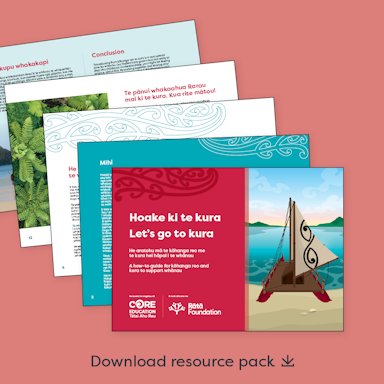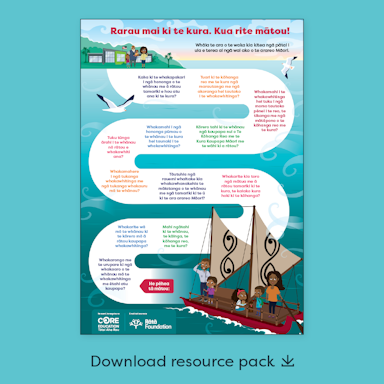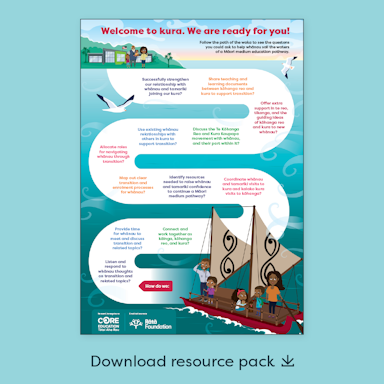Te whakakaha i ngā hononga | Supporting connections for our tamariki
What was the project about?
In this project we set out to explore the transitions of tamariki and their whānau from two kōhanga reo settings to two kura kaupapa Māori settings in Christchurch. We wanted to find out:
- what whānau need to make informed decisions about a Māori medium pathway
- how kaiako, kōhanga reo and kura can effectively support tamariki and their whānau to make this transition.
Sending tamariki to a kaupapa Māori learning setting is a political act. For whānau the transition to kura can be an especially emotionally challenging decision. Taking a kaupapa Māori pathway enacts rangatiratanga, and reclaims and builds identity, language and culture. For many whānau this process happens alongside tamariki as they integrate into kōhanga and kura life. For whānau who are early on their reclamation journey, whakamā (shame), fear and uncertainty of the long-term benefits of kaupapa Māori pathways present barriers.
The broader whakapapa of the project
In 2017, discussions began between Tātai Aho Rau Core Education, Rātā Foundation, and the Ministry of Education around transitions for tamariki from early learning services to schools. Evidence showed that some tamariki continued to face barriers to learning success. Tātai Aho Rau was invited by the Rātā Foundation to submit an action-research proposal with a focus on transitions to school.
Our proposal had two streams. One for English medium, Te hautū i te awa whiria o ako – Supporting pathways to lifelong learning for English medium schools, which was:
- tamariki-centred
- focused on promoting positive transition experiences in collaboration with primary school teachers.
And the Māori medium stream, Kia hoe tahi i te awa kōwhiria o ako – Mobilising whānau commitment to Māori medium pathways, which was:
- whānau-centred
- focused on identifying the enablers and barriers for whānau and tamariki in maintaining a Māori medium pathway, and how the education ecosystem could support them.
-
Why choose a whānau-centred approach to transition?
Our report drew on international findings on effective bilingual education that highlighted the importance of transitions that support continuity of learning. This research indicates that to experience the benefits of high quality kaupapa Māori education, tamariki and their whānau need to remain on a kaupapa Māori learning pathway for a minimum of six years, and ideally for eight years.
We were driven by the significance that kaupapa Māori education pathways have for both te reo Māori regeneration and Māori education success. We sought to affirm the fundamental role of whānau in the emergence and development of Kōhanga Reo and Kura Kaupapa Māori.
-
Who led the research?
Kia hoe tahi i te awa kōwhiria o ako – Mobilising whānau commitment to Māori medium pathways was a whānau-centred research project led by kaiako researchers from kura kaupapa and kōhanga Reo in Christchurch. Kaiako researchers were supported by a facilitator researcher and lead researcher to collect and analyse whānau and tamariki voices. The next phase of the kaupapa Māori action-research was a pakirehua phase outlined below.
What we learned
Transition is not the focus, it is the outcome. The focus instead needs to be on creating connections and engagement, hononga, across the whānau through incremental deliberate acts enabled by the kōhanga reo and the kura. (Researcher-facilitator reflection)
The research findings showed that effective transitions are based on creating and sustaining hononga (connections) with whānau and their tamariki. These were enabled through strengthening connections:
- between settings
- to shared kaupapa
- to identity as Māori
- to develop knowledge and understanding
What we did – the pakirehua
Following the wānanga phase which gathered whānau and kaimahi (staff) voices around transition experiences, kaiako researchers paired up to undertake a collaborative inquiry. Each inquiry group was made up of one kōhanga and one kura.
The inquiry question we asked kaiako was:
How might we strengthen connections across the learning ecosystem, so that whānau are confident to commit to a Māori medium pathway for their tamariki-mokopuna?
-
Connecting with tamariki
- Kaiako kura visiting tamariki at kōhanga
- Tamariki from kōhanga visiting kura
- Tamariki kura designing books for teina in kōhanga to get ready for kura
-
Connecting with whānau
- Wānanga ā-whānau around transitions
- Kaiako kura attending kōhanga
- Designing a book demonstrating key links between kōhanga and kura
-
Connecting between kōhanga and kura
- Co-planning between kōhanga and kura
- Shared professional learning between kōhanga and kura
- Teaching tamariki from kōhanga waiata, pao, and karakia from kura
Resources
Download the packs below - a 'how to support whānau and kura' guide with printable planning templates in reo and English, and helpful guiding questions (A3 sized infographic) in both reo and English with printable planning templates.
Kaupapa Māori concepts and practices used
Alongside hui (hui pūrua and hui kaiako takitahi), wānanga was the principal technique used in the project as a forum for discussion, deliberation and theorising. We also used mātakitaki, uiuinga, and pukapuka kōrero inside and outside of wānanga and hui.
We drew on methods used successfully in recent research to gather data and information with tamariki including tuhituhi, tāpoi tamariki and hopu whakaahua.
More detail on these concepts and practices are on pages 20-23 of the report.



